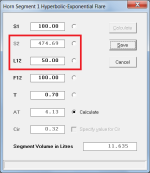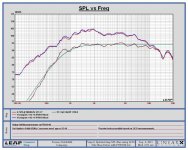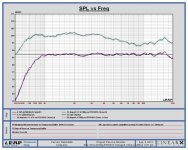In purely exponential horns, m = constant throughout the horn expansion.
In hypex horns, m increases monotonically from throat to mouth.
For an exponential horn, m = ln(S2 / S1) / L12
For a hyperbolic-exponential (hypex) horn, m = 2 * Pi * F12 / c
Where:
S1 = horn throat area
S2 = horn mouth area
L12 = horn axial length
F12 = horn flare cutoff frequency
ln = natural logarithm
c = speed of sound
This is a great thread topic. Thank you Pano for kicking this off. One can view the adapter as a minihorn, the effect of which on the driver and waveform is amplified by the main horn.
As I have been thinking about this recently, the adatper's throat expansion profile aims to achieve simultaneously four objectives:
1. transition the waveform periphery from one geometric shape matching the driver to another matching the horn (e.g. circle to square).
2. provide a surface area expansion rate that matches that of the horn.
3. avoid angular discontinuity of the walls along the waveform path.
4. for some horns, transition the curvature of the wavefront from one 3D shape to another (e.g. spherical to cylindrical).
Failure to do so will result in sub-optimal loading of the driver (impacting frequency and phase response), diffraction and standing waves (impacting the time response).
If satisfying no. 1 precisely is a given, then satisfying nos. 2, 3 and 4 together is in most cases a tradeoff exercise. Regarding no. 2, the surface areas of the adapter entrance and exit, together with horn expansion rate data uniquely specify an optimal adapter length. Alas the rest is pretty much an exercise in compromise. Some commercial adapter I have received don't even meet the necessary length for no. 2!
Having been listening to a TAD horn for over a month now, I find that it sounds better than it has any right to do. Since it and the driver do respond to changes to the throat adapter, I wonder how much I can further improve their sound.
I am curious to learn about what you all think of the relative importance of objectives nos. 2, 3, and 4 above? I have read some advocating no. 3 over 2, no. 2 over 3, and only a few mentioning no. 4. What else am I missing? Views welcome.
As I have been thinking about this recently, the adatper's throat expansion profile aims to achieve simultaneously four objectives:
1. transition the waveform periphery from one geometric shape matching the driver to another matching the horn (e.g. circle to square).
2. provide a surface area expansion rate that matches that of the horn.
3. avoid angular discontinuity of the walls along the waveform path.
4. for some horns, transition the curvature of the wavefront from one 3D shape to another (e.g. spherical to cylindrical).
Failure to do so will result in sub-optimal loading of the driver (impacting frequency and phase response), diffraction and standing waves (impacting the time response).
If satisfying no. 1 precisely is a given, then satisfying nos. 2, 3 and 4 together is in most cases a tradeoff exercise. Regarding no. 2, the surface areas of the adapter entrance and exit, together with horn expansion rate data uniquely specify an optimal adapter length. Alas the rest is pretty much an exercise in compromise. Some commercial adapter I have received don't even meet the necessary length for no. 2!
Having been listening to a TAD horn for over a month now, I find that it sounds better than it has any right to do. Since it and the driver do respond to changes to the throat adapter, I wonder how much I can further improve their sound.
I am curious to learn about what you all think of the relative importance of objectives nos. 2, 3, and 4 above? I have read some advocating no. 3 over 2, no. 2 over 3, and only a few mentioning no. 4. What else am I missing? Views welcome.
Last edited:
#2 seems to gain importance as the dimensions increase and affected frequencies decrease. While the dimensions are stiIl small, the pressure quickly equalizes across the surface of the expanding wave front, so for there to be echoes they would have to be ultrasonic.
If I mentally subdivide a horn into a 'mesh' of small pyramid-like sections, I can imagine issues similar to cone break-up, whereby echoes from the solid horn boundaries travel across the surface of the expanding wave (assuming the error is very small so the reflection angle doesn't delay the sound by much compared to the maximum 'wave' speed). These error ripples can then converge at phantom boundaries, like at a mid-point for an exponential horn (a la mid-point of a dome tweeter's surface), or at a middle line for a radial horn.
If I mentally subdivide a horn into a 'mesh' of small pyramid-like sections, I can imagine issues similar to cone break-up, whereby echoes from the solid horn boundaries travel across the surface of the expanding wave (assuming the error is very small so the reflection angle doesn't delay the sound by much compared to the maximum 'wave' speed). These error ripples can then converge at phantom boundaries, like at a mid-point for an exponential horn (a la mid-point of a dome tweeter's surface), or at a middle line for a radial horn.
Both of these are what I have long heard and read are important. But how do we know what we have, what will be a good match? In my "life with horns" I have been lucky enough (or lazy enough) to use drivers that were meant for the horn I had. Not 100%, but most. However, how does a DIYer who has a horn choose a driver that will match it well? You might choose a driver horn combo from which you've seen good results. But what if you have an unknown driver or horn, how would you set about choosing wisely?As I have been thinking about this recently, the adatper's throat expansion profile aims to achieve simultaneously four objectives:
1. transition the waveform periphery from one geometric shape matching the driver to another matching the horn (e.g. circle to square).
2. provide a surface area expansion rate that matches that of the horn.
For example, let's look at the Yuichi horn. It has a rapid horizontal expansion, but no vertical expansion for the first half. As Lynn Olson says;
It looks that way to me too, although other people say no. It's been stated on the forum that the average expansion of the Yuichi is a 290Hz Hypex horn T=0.7 Below shows the profile that would be if it were a simple axi-symetric horn. Yellow is the 290Hz hypex flare, and the red and green triangles show what a conical horn of a given degree would look like. NOTE: This is NOT the wavefront or sound expansion, this just shows what a continuation of the conical horn inside the compression driver would look like. We see 21° like the Radian 950, and 10° like the JBL of TD-4001. Which of these conical expansions matches the early part of the Hypex expansion. To my surprise, the 10° seems a slightly better match.The Yuichi A290 looks a Smith horn for the first part of the expansion, but avoids the mouth diffraction that characterizes the classical Smith horn by adding a further vertical expansion right where the Smith horn would typically end.
Of course the Yuichi profile is more complex than this, but at least it's a first look. Is this useful in understanding which driver geometry might be a good match for a give horn?
Not very.Is this useful in understanding which driver geometry might be a good match for a give horn?
It's more complicated than that.
It's too late now here, but I'll try and find the time to post an explanation over the weekend.
That makes it sound as if m is a constant, which - in a hypex horn - it isn't.For a hyperbolic-exponential (hypex) horn, m = 2 * Pi * F12 / c
At least not if m is defined as 1/Sx * dSx/dx
Thanks, that would be very helpful. 👍 Nowhere have a found a clear explanation or thorough of how to match a horn and driver. Looking forward to reading what you come up with.I'll try and find the time to post an explanation over the weekend.
That makes it sound as if m is a constant, which - in a hypex horn - it isn't.
At least not if m is defined as 1/Sx * dSx/dx
In the case of an exponential or hyperbolic-exponential (hypex) horn, m is normally used as the symbol for the flare constant. T is normally used as the symbol for the hyperbolic-exponential horn flare parameter.
The cross-sectional area at distance x from the throat of a hyperbolic-exponential horn is given by:
Sx = S1 * (-(1 + T) * Exp(m * x) - (1 - T) / Exp(m * x)) ^ 2 / 4
Where:
Sx = area at distance x from horn throat
S1 = horn throat area
T = flare parameter
x = distance from horn throat
m = flare constant = 2 * Pi * F12 / c
F12 = flare cutoff frequency
c = speed of sound
If:
S1 = 100 cm^2
T = 0.7
x = 50 cm
F12 = 100 Hz
c = 34400 cm /sec
Then:
m = 2 * Pi * 100 / 34400 = 0.018265
Sx = 100 * (-(1 + 0.7) * Exp(0.018265 * 50) - (1 - 0.7) / Exp(0.018265 * 50)) ^ 2 / 4
Sx = 474.69 cm ^2
(As shown in the attachment)
Given flare rate = 1 / Sx * dSx / dx
Then for a hyperbolic-exponential horn:
Flare rate will increase with horn length if T < 1 (Cosh horn).
Flare rate will decrease with horn length if T > 1 (Sinh horn).
Flare rate will remain constant with horn length if T = 1 (Exponential horn).
Attachments
I found this video of a cool company that makes wood conical horns, and they talk about the driver used with it. I would like to hear it!
@Pano
Allow me to re-direct this conversation somewhat ( best-of-luck keeping all this on point 😉 ).
I do think I understand the motive behind this thread as ( ie ; How to avoid making expensive mistakes ( like Kevin did ) when choosing a driver//horn combo ). Correct me if I'm wrong.
The driver; Radian 950pb AL
So, before I can accept the concept that all of the response problems that Kevin encountered were caused by a horn//driver mismatch > I'll need to see that 950pb driver mated to a more ideal horn.
- ( I would really prefer to see this drivers measured planewave response ).
IOW; I now need to see his drivers perform well on something ( really any large horn ) where good response is expected down to at least 500hz ).
- I would need to see before I can rule out the driver as being the source of the response problem ( there's a caveat here that follows-on from my longish post ).
Perhaps Kevin can find a volunteer who's willing to mate one of his drivers to a Klipsch K402( or some similar large sized horn ) and then measure that combos response.
Moving on ( from a product research perspective ); a picture like the following gives me real pause. If I was interested in buying this driver ( and then saw this pic ) I would want to know exactly what I was looking at here, ( down inside that throat ).
- IOW; do all 5 of the exits ( belonging to the 5-slit phase plug ) terminate down within the darker center region of this pic /// or is it just 4 ?? with the 5th exit terminating to the outside of the lighter//whiter circular band ??
The answer to that question would help determine if I thought the driver was designed properly and might want to own it.

The following is a response pic for the 950pb AL ( which I'm sure Radian might just regret having published in the first place ).
It's a bit hard to believe, but this response graph which is actually grabbed from one of their earliest spec-sheets for the 950pb.
- I'll attach that spec-sheet below as a pdf, along with 2 more modern cut-sheets showing better responses.
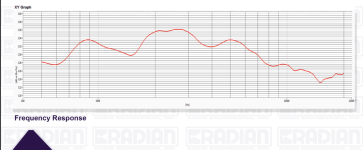
One has to ask; what was Radian thinking by publishing that graph ?? ( assuming they wanted to sell these drivers ).
It's all a bit Clouseau-esque.
I'll assume that Kevin wasn't in possession of this specific cut-sheet when he was researching buying this driver.
Here's an almost identical pic ( published by Martin Poulin on his web-page ) .
This pic is one that Radian had sent to Martin when he had inquired about a suspected change within the 950pb production line ( that Martin measured as quite a radical change in the raw impedance curve to his older pair ).
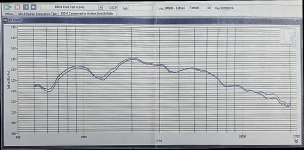
Radian states that the provided curve is the expected QC response of a driver when mated to their test horn ( that then exits into a box where it's then measured ) and is then compared against a Radian "Golden Unit" for QC.
Worth noting here is the very good response that Martin achieved with his older pair of drivers when mated to a 340hz JMLC horn.
- I've traced his response graphs ( with VituixCAD2 ) and provide them here in a more digestible format ( after re-importing them into REW for display ).

These response graphs were made with the older//used 950pb's that Martin bought ( from Portugal ) which have the lower Fs figures.
As far as I know, Martin never lashed up his newer 950pb ( to one of his JMLC horns ) and then measured it for a response comparison to his older pair of Radian drivers.
- His newer 950pb driver is mounted on a single 350hz Tractrix horn ( from AutoTech ).
Here's the ( new driver vs older ) comparison ( on 2 different horns );
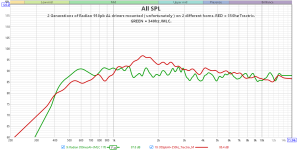
- Here's the story of his investigation into the measured change of the impedance curves.
![3f5ca2_e98b030c036147979aec424aa635dc58~mv2[1].png 3f5ca2_e98b030c036147979aec424aa635dc58~mv2[1].png](https://www.diyaudio.com/community/data/attachments/1067/1067956-94c60abb120fce2f865f57882e7b3ebd.jpg?hash=lMYKuxIPzi)
vs
![950pb%20impedance%20after%2060%20hourds_JPG[1].jpg 950pb%20impedance%20after%2060%20hourds_JPG[1].jpg](https://www.diyaudio.com/community/data/attachments/1067/1067957-24f7f2f47b836eded44a864dd1f3276f.jpg?hash=JPfy9HuDbt)
Staggering Towards a Conclusion:
A little bit of Conjecture///Speculation:
(i) Perhaps Radian changed the structure of the throat section within the newer 950pbs ( by leaving out a previously inserted + tapered throat section ) effectively making a driver meant only for use above 1000hz ( as is quite typical for many Pro-Audi prodocts ) .
(ii) Perhaps it was all due to a change in the suspension of the R1245 diaphragm ( though Radian denies this ).
(iii) Perhaps everything I've posted is nothing more than a few odd coincidences ( tenuously tied to Kevin's plight ) and so, is nothing more than a Red-Herring.
Martin Poulin would be able to clear up my speculation ( since he clearly has old and new 950pb product that measure differently )
EarlK 🙂
Allow me to re-direct this conversation somewhat ( best-of-luck keeping all this on point 😉 ).
I do think I understand the motive behind this thread as ( ie ; How to avoid making expensive mistakes ( like Kevin did ) when choosing a driver//horn combo ). Correct me if I'm wrong.
The driver; Radian 950pb AL
So, before I can accept the concept that all of the response problems that Kevin encountered were caused by a horn//driver mismatch > I'll need to see that 950pb driver mated to a more ideal horn.
- ( I would really prefer to see this drivers measured planewave response ).
IOW; I now need to see his drivers perform well on something ( really any large horn ) where good response is expected down to at least 500hz ).
- I would need to see before I can rule out the driver as being the source of the response problem ( there's a caveat here that follows-on from my longish post ).
Perhaps Kevin can find a volunteer who's willing to mate one of his drivers to a Klipsch K402( or some similar large sized horn ) and then measure that combos response.
Moving on ( from a product research perspective ); a picture like the following gives me real pause. If I was interested in buying this driver ( and then saw this pic ) I would want to know exactly what I was looking at here, ( down inside that throat ).
- IOW; do all 5 of the exits ( belonging to the 5-slit phase plug ) terminate down within the darker center region of this pic /// or is it just 4 ?? with the 5th exit terminating to the outside of the lighter//whiter circular band ??
The answer to that question would help determine if I thought the driver was designed properly and might want to own it.
The following is a response pic for the 950pb AL ( which I'm sure Radian might just regret having published in the first place ).
It's a bit hard to believe, but this response graph which is actually grabbed from one of their earliest spec-sheets for the 950pb.
- I'll attach that spec-sheet below as a pdf, along with 2 more modern cut-sheets showing better responses.

One has to ask; what was Radian thinking by publishing that graph ?? ( assuming they wanted to sell these drivers ).
It's all a bit Clouseau-esque.
I'll assume that Kevin wasn't in possession of this specific cut-sheet when he was researching buying this driver.
Here's an almost identical pic ( published by Martin Poulin on his web-page ) .
This pic is one that Radian had sent to Martin when he had inquired about a suspected change within the 950pb production line ( that Martin measured as quite a radical change in the raw impedance curve to his older pair ).

Radian states that the provided curve is the expected QC response of a driver when mated to their test horn ( that then exits into a box where it's then measured ) and is then compared against a Radian "Golden Unit" for QC.
Worth noting here is the very good response that Martin achieved with his older pair of drivers when mated to a 340hz JMLC horn.
- I've traced his response graphs ( with VituixCAD2 ) and provide them here in a more digestible format ( after re-importing them into REW for display ).
These response graphs were made with the older//used 950pb's that Martin bought ( from Portugal ) which have the lower Fs figures.
As far as I know, Martin never lashed up his newer 950pb ( to one of his JMLC horns ) and then measured it for a response comparison to his older pair of Radian drivers.
- His newer 950pb driver is mounted on a single 350hz Tractrix horn ( from AutoTech ).
Here's the ( new driver vs older ) comparison ( on 2 different horns );

- Here's the story of his investigation into the measured change of the impedance curves.
![3f5ca2_e98b030c036147979aec424aa635dc58~mv2[1].png 3f5ca2_e98b030c036147979aec424aa635dc58~mv2[1].png](https://www.diyaudio.com/community/data/attachments/1067/1067956-94c60abb120fce2f865f57882e7b3ebd.jpg?hash=lMYKuxIPzi)
vs
![950pb%20impedance%20after%2060%20hourds_JPG[1].jpg 950pb%20impedance%20after%2060%20hourds_JPG[1].jpg](https://www.diyaudio.com/community/data/attachments/1067/1067957-24f7f2f47b836eded44a864dd1f3276f.jpg?hash=JPfy9HuDbt)
Staggering Towards a Conclusion:
A little bit of Conjecture///Speculation:
(i) Perhaps Radian changed the structure of the throat section within the newer 950pbs ( by leaving out a previously inserted + tapered throat section ) effectively making a driver meant only for use above 1000hz ( as is quite typical for many Pro-Audi prodocts ) .
(ii) Perhaps it was all due to a change in the suspension of the R1245 diaphragm ( though Radian denies this ).
(iii) Perhaps everything I've posted is nothing more than a few odd coincidences ( tenuously tied to Kevin's plight ) and so, is nothing more than a Red-Herring.
Martin Poulin would be able to clear up my speculation ( since he clearly has old and new 950pb product that measure differently )
EarlK 🙂
Attachments
Last edited:
Thanks Earl. Yes, the title could be "How to avoid making expensive mistakes when choosing a driver for your horn." From I have read and heard over the years, the information on how to do this hasn't been available, or at least not user friendly. And it should be.
Your photo above of the Radian I have seen before and noticed the curious step in the throat. What is it there for, and what does it do to the response? I have a pair of early Radian 1.4" drivers that don't look like that at all. I thought that Kevin had some measurements of the 950s on a JBL horn, but maybe he no longer has them.
It will be interesting to read what @marco_gea has to say. As far as I can tell, all 21st century style CDs have a short, wide conical flare. How do we match that to a particular horn? Do we design a throat adapter with Hornresp or something like @jzagaja showed us in post #4? How do you do that if the driver exit and the horn entrance are the same size?
Your photo above of the Radian I have seen before and noticed the curious step in the throat. What is it there for, and what does it do to the response? I have a pair of early Radian 1.4" drivers that don't look like that at all. I thought that Kevin had some measurements of the 950s on a JBL horn, but maybe he no longer has them.
It will be interesting to read what @marco_gea has to say. As far as I can tell, all 21st century style CDs have a short, wide conical flare. How do we match that to a particular horn? Do we design a throat adapter with Hornresp or something like @jzagaja showed us in post #4? How do you do that if the driver exit and the horn entrance are the same size?
I must say, hurray to drivers that's throat-less. After thinking long and hard on this topic I came to the question....why are not all modern drivers made to have the exit right at the end of the phase plug? With shallow Nd magnets there is no reason for a "snout" on any driver really.
//Anders
//Anders
It will be interesting to read what @marco_gea has to say. As far as I can tell, all 21st century style CDs have a short, wide conical flare. How do we match that to a particular horn?
( From what I see ) Martin gets excellent lower end response from his older Radians mated to his 340hz JMLC horns.
Does anyone know if the flare rates of that horn and Radian driver actually match?? ( or is it assumed they do because the FR looks good )
I should mention that I post this pic because Martin seems focused on improving the response of his driver//horn combo by lowering the Fs of the driver ( which is why he was disturbed to find out that his new 950pb had an Fs one octave higher than his older pair.
I happen to share that as a priority ( compared to religiously matching flare rates ).
🙂
Last edited:
Really interesting points being made here. Just throwing this out ... do all radial horns have square entrances? I know the Yuichi A290 and many multicell horns have square entrances, and some multicells have what amounts to an internal adapter to transition from circular to square in the horn itself.
I didn't see this mentioned yet could have missed it though. How are you doing your CD/Horn/Waveguide EQ?? With a passive network or with a digital loudspeaker management system. Passive does have limitations as far as complexity but can achieve excellent results. With digital you can brute force just about anything.
Then you have traditional horns like exponential that will work with say a 2426 but not a new dual diaphragm 2420 as an example without some EQ comp on your traditional horns.
Then you have throat less vs throat.
Then you have radiation pattern and CD horns which by definition require EQ. An example about a CD waveguide and drivers are 435Be vs any 1.5" throat less large format 2450 family drivers. Using a wide pattern CD 100x100 as an example you can't really get the last octave because of the Be roll off without padding the daylights out of it in comparison the the 2450 family.
The 2450's are rising or flat where the Be is rolling off. You need to look at the driver and horn response to get an idea of how well the two will match.
Rob 🙂
Then you have traditional horns like exponential that will work with say a 2426 but not a new dual diaphragm 2420 as an example without some EQ comp on your traditional horns.
Then you have throat less vs throat.
Then you have radiation pattern and CD horns which by definition require EQ. An example about a CD waveguide and drivers are 435Be vs any 1.5" throat less large format 2450 family drivers. Using a wide pattern CD 100x100 as an example you can't really get the last octave because of the Be roll off without padding the daylights out of it in comparison the the 2450 family.
The 2450's are rising or flat where the Be is rolling off. You need to look at the driver and horn response to get an idea of how well the two will match.
Rob 🙂
Attachments
Last edited:
Just throwing this out ... do all radial horns have square entrances?
No ( some are round ), the Emilar EH500 radial for instance has a round 2" entrance ( and is quite well regarded by those who use it, which includes myself > with an Altec 288-8K on an Eminence adapter ).
- The EH500 is a smidge smaller than an Altec 811b.
It has ( what I call ) the RCA 1960's bell-pinch found just inside the horn bell ( by a couple of inches ) which forces a bit of HF redirection towards the sides.
The bell "pinch" brings the horn-bells together to about 1.25" ( from the 2" entrance ). Fluid dynamics ( iow; water-hose end finger pinch ) says this causes a spreading of content.
🙂
Last edited:
In the case of the Muiltcell horns I've seen, there is a somewhat gentle transition from round to square. Some examples below.many multicell horns have square entrances, and some multicells have what amounts to an internal adapter to transition from circular to square in the horn itself.
On the throat adapter for the Altec 803 horn the vertical dimension remains at 1.4" up to the joint with the horn. The horizontal dimension of the adapter expands.
In the case of the little wooden Pioneer horns seen above, the transition is longer and in both axis.
AFAIK, the red line is 44.4 degrees off axis. He is showing the effects both on and off axis.What's the significance of this one pic ?? ( I don't understand the red-line ).
I've used both, and a combination of both. With passive it's fairly easy to reduce the midrange hump and add a shelf filter for the top end, and that's the approach used by many good crossovers. With digital I've done basically the same thing, and them added or refined on top of that. Digital is faster to get good results.How are you doing your CD/Horn/Waveguide EQ??
- Home
- Loudspeakers
- Multi-Way
- Matching horns to compression drivers, a discussion
